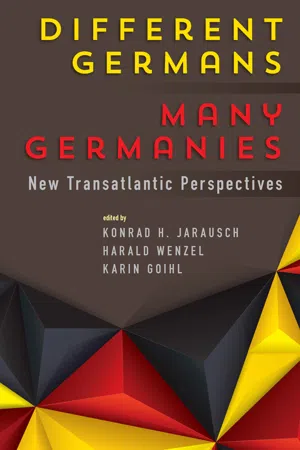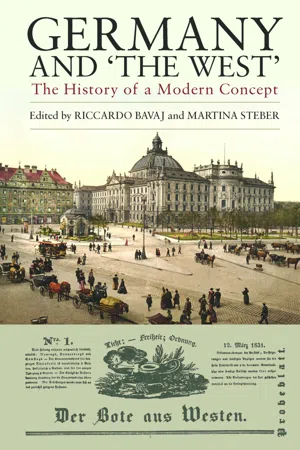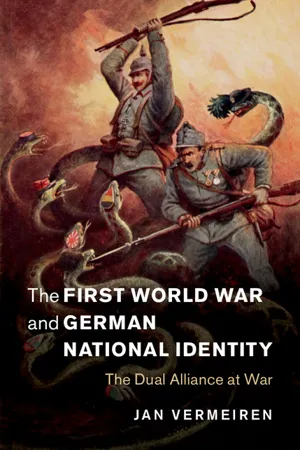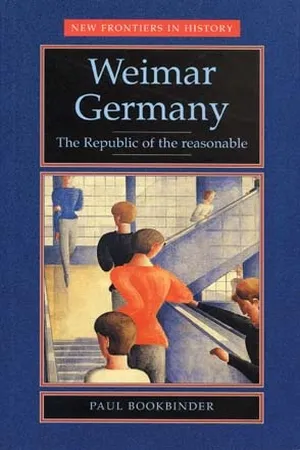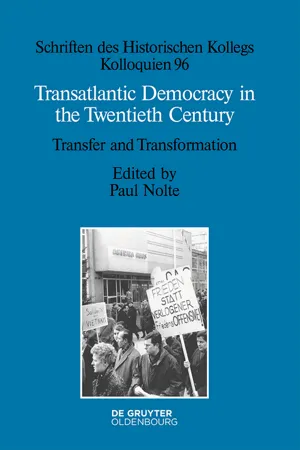History
Kaiserreich
Kaiserreich refers to the German Empire, which existed from the unification of Germany in 1871 until the end of World War I in 1918. During this time, the country was ruled by a Kaiser (emperor) and experienced significant industrial and military expansion. The Kaiserreich ultimately collapsed following Germany's defeat in World War I and the abdication of Kaiser Wilhelm II.
Written by Perlego with AI-assistance
Related key terms
1 of 5
6 Key excerpts on "Kaiserreich"
- eBook - ePub
Ethnic Minorities in 19th and 20th Century Germany
Jews, Gypsies, Poles, Turks and Others
- Panikos Panayi(Author)
- 2014(Publication Date)
- Routledge(Publisher)
CHAPTER 3The Kaiserreich , 1871–1918: Prejudice, Exploitation and Full EmancipationT he German nation state which came into existence in 1871 evolved from the economic, social and political transformations taking place in central Europe during the nineteenth century. In the period leading up to the First World War and the defeat which followed, the new political entity continued to experience many of the developments which characterized the decades leading to its formation. In addition, those in power attempted to mould the new state, although they often faced popular opposition from a series of movements from both the left and the right.The German nation state revealed itself as the most powerful on the European continent. The basis of this position lay in concrete geographic, economic and social facts. Although smaller in size than the massive area controlled by the Russian autocracy, as well as the crumbling Ottoman Empire, it rivalled or surpassed the other large European states of France, Great Britain, the declining Habsburg Empire, the largely irrelevant and distant Spain, and the equally new Italy. In addition, the first German nation state had the advantages of a growing population, which would surpass the size of many of its rivals by the outbreak of the First World War. Expanding at a yearly average of more than ten per cent, the number of people living within the German Empire grew from 40,995,000 in 1875 to 64,568,000 by 1910.1 In this year, Germany represented the second most populous state on the continent, way behind Russia’s 160.7 million inhabitants, but considerably ahead of the UK with 40.8 million residents.2In economic and social terms Germany has far more in common with Britain than Russia, as the process of industrialization, which had begun to take off earlier in the century, really reached fruition after 1871. Therefore, by the outbreak of the First World War, Germany had become a predominantly, but by no means exclusively, industrial state, which rivalled Britain, ‘the workshop of the world’ during the middle of the nineteenth century. Thus, the share of agriculture in the German GNP remained at between 35 and 40 per cent until the 1880s but fell back to stand at 25 per cent by the outbreak of the First World War, when industry’s share had increased to 45 per cent, while the commercial and service sector made up the remaining 30 per cent.3 The transformation took place in the heavy industries of coal, iron, steel, and railway building, which had also formed a major basis of British growth, as well as the new area of chemicals, where Germany reigned supreme because of the strength of her university science departments. By 1914 the new state produced more iron and coal than Britain.4 - eBook - PDF
Different Germans, Many Germanies
New Transatlantic Perspectives
- Konrad H. Jarausch, Harald Wenzel, Karin Goihl, Konrad H. Jarausch, Harald Wenzel, Karin Goihl(Authors)
- 2016(Publication Date)
- Berghahn Books(Publisher)
Far from being viewed as incompatible, American observers curiously studied the Wilhelmine Empire as a fellow—statist—pioneer of modernity. German society came to exemplify state intervention in meeting shared challenges wrought by industrialization, urbanization, and mass culture. Hence the German example could include both positive and negative connotations, but the identity of the challenges reinforced its relevance to American observers. Hence the observers’ perspectives could accommodate ambivalent perceptions. For example, high esteem for vigorous municipal government stood in stark contrast to the skepticism for Wilhelm II and his political regime. This ambivalence of American contemporaries conflicts with an estab -lished historiographical interpretation of the Kaiserreich. Hans-Ulrich Wehler has continuously portrayed the Wilhelmine era as the watershed moment for German divergence onto its ultimately destructive Sonderweg . 2 Multiple historians have resisted such sweeping judgments, maintaining that study of the Kaiserreich should not limit itself to the “sum of its flaws.” 3 Recent literature has supported this view by pointing to the Kaiserreich’s economic dynamism, social volatility, and close global links. 4 More broadly, the rise of an entire field of subaltern studies within the last twenty-five years has questioned the existence of a single benign modernity in the Anglo-American vein upon which the Sonderweg thesis rests. Instead, schol-ars such as Arjun Appadurai and Dipesh Chakrabarty have opened up fruitful new research questions by insisting that multiple modernities could interact with each other—although far too often uneasily. 5 But since the late 1980s, other scholars have reevaluated the years from 1890 to 1914–17 as a pivotal, if contradictory era of its own, rather than merely the prehistory of the Great War. - eBook - PDF
Germany and 'The West'
The History of a Modern Concept
- Riccardo Bavaj, Martina Steber(Authors)
- 2015(Publication Date)
- Berghahn Books(Publisher)
Perspektiven einer transnationalen Geschichte , Berlin, 2004. 8. See Thomas Müller, Imaginierter Westen. Das Konzept des ‘deutschen Westraums’ im völkischen Diskurs zwischen Politischer Romantik und Nationalsozialismus , Bielefeld, 2009. 9. Max Weber, Wirtschaft und Gesellschaft , 5th edn, Tübingen, 1972, 242. 10. Charles S. Maier, ‘Consigning the Twentieth Century to History. Alternative Narra-tives for the Modern Era’, American Historical Review 105 (2000), 808. The Kaiserreich and the Kulturländer • 67 11. Adolph Wagner, Vom Territorialstaat zur Weltmacht , Berlin, 1900, 6. 12. Ibid., 8. 13. Conrad, Globalisierung und Nation im Deutschen Kaiserreich , 334. 14. Heinrich von Treitschke, Selections from Treitschke’s Lectures on Politics , London, 1914, 10. 15. Ibid. 16. Alldeutsche Blätter in 1908, quoted in Roger Chickering, We Men Who Feel Most Ger-man. A Cultural Study of the Pan-German League, 1886–1914 , London, 1984, 123. 17. Treitschke, Selections from Treitschke’s Lectures on Politics , 10. 18. See Mark Hewitson, ‘The Kaiserreich in Question’, Journal of Modern History 73 (2001), 738–80. 19. Friedrich Naumann in Die Hilfe , 1900, no. 28; Oscar A.H. Schmitz, Das Land der Wirklichkeit , Munich, 1914, 22–23, 38, 56–57, 61, 67–68, 73, 111, 114–15, 142, 146; Karl Hillebrand, Frankreich und die Franzosen , 4th edn, Strasbourg, 1898, 9. 20. See Mark Hewitson, ‘The Wilhelmine Regime and the Problem of Reform’, in Geoff Eley and James Retallack (eds), Wilhelminism and its Legacies , New York, 2003, 76–86. 21. Karl Lamprecht, cited in Frank Trommler, ‘Inventing the Enemy. German-American Cultural Relations, 1900–1917’, in Hans-Jürgen Schröder (ed.), Confrontation and Cooperation. Germany and the United States in the Era of World War I , Oxford, 1993, 113; David E. Barclay and Elisabeth Glaser-Schmidt (eds), Transatlantic Images and Perceptions. - eBook - PDF
The First World War and German National Identity
The Dual Alliance at War
- Jan Vermeiren(Author)
- 2016(Publication Date)
- Cambridge University Press(Publisher)
95 However, as we will see, the Central European idea became an official objective and a more popular project only under the new conditions of the First World War. Reichsnation, Kulturnation, Volksnation: defining Germany after 1871 In one of his famous Berlin lectures on politics, Treitschke stated that ‘for many centuries it had been our tragedy that no one knew where Germany ends’. 96 The events of 1866 and 1870–71 brought a compelling answer, and the following years and decades proved that, for the large majority of Reich Germans at least, there was no German question any more. Grandeur et décadence d’une géopolitique (Paris, 1990); S. Neitzel, Weltmacht oder Untergang. Die Weltreichslehre im Zeitalter des Imperialismus (Paderborn, 2000); C. Torp, Die Herausforderung der Globalisierung. Wirtschaft und Politik in Deutschland 1860–1914 (Göttingen, 2005); D. van Laak, Über alles in der Welt. Deutscher Imperialismus im 19. und 20. Jahrhundert (Munich, 2005). 93 F. Ratzel, Politische Geographie (Munich, 1897), p. 337. 94 K. v. Winterstetten [i.e. A. Ritter], Berlin-Bagdad. Neue Ziele mitteleuropäischer Politik, 8th ed. (Munich, 1914), p. 17. 95 James, A German Identity, p. 103. 96 H. v. Treitschke, Politik. Vorlesungen gehalten an der Universität zu Berlin, ed. by Max Cornelicus, 2 vols., 5th ed. (Leipzig, 1922 [orig. 1897-98]), II, p. 338. 44 The First World War and German National Identity Although it was widely acknowledged that one did not live in an ‘ideal nation-state’, a new, state-centred German identity evolved. 97 ‘Germany’, which had earlier been defined in linguistic and cultural terms or politically as the territory of the German Confederation, became increasingly associated with the borders, institutions, and citizens of the Kaiserreich. More than before 1871, state and nation were interrelated and intertwined. - eBook - PDF
Weimar Germany
The republic of the reasonable
- Paul Bookbinder(Author)
- 2024(Publication Date)
- Manchester University Press(Publisher)
The federal constitution also provided for an upper legislative 5 Weimar Germany house, a Bundesrat, whose consent was needed for constitutional change and whose members were chosen by the state govern- ments. Prussia's block of seventeen delegates was sufficient on its own to prevent constitutional changes. The constitution also put great power in the hands of the chief executive, the Emperor or Kaiser, who was also the King of Prussia. The chief administrative officer of the state, the Chancellor, and his cabinet were responsi- ble to the Kaiser but not to the legislature. The personality of the Kaiser, Wilhelm II, who was Germany's ruler in 1914 at the beginning of World War I, and the nature of his inner circle of confidants were important factors in the evolution of this society. The Kaiser began his rule in 1888 as a young man who proclaimed concern for the working people of Germany and who did not appear to be a rigid conservative. His parents had embodied the liberals' hope for the future of Germany. His father, Friedrich and his mother, who was the eldest daughter of Queen Victoria of England, were intent on moving Germany towards a true constitutional monarchy where class, ethnic and religious differences would be of less importance. Wilhelm's father was critically ill with cancer when he inherited the throne from his brother Wilhelm I and died within three months. His son was in many ways closer in outlook to his uncle than to his father or mother. He rebelled against their generally more liberal orienta- tion and veered sharply away from any early promise of moder- ation. By the turn of the twentieth century, Wilhelm II had sur- rounded himself with those who encouraged his limited and most reactionary instincts. As Isabell Hull describes Wilhelm's circle of intimates, "Their milieu fostered the narrowest and most conservative aspects of Wilhelm's eclectic Weltanschauung." He spent most of his adult life trying to be something he was not. - eBook - PDF
Transatlantic Democracy in the Twentieth Century
Transfer and Transformation
- Paul Nolte(Author)
- 2016(Publication Date)
- De Gruyter Oldenbourg(Publisher)
20 As a result, 17 See Sigmund Neumann: Die Parteien der Weimarer Republik. Stuttgart 1955. See also Thomas Nipperdey: Die Organisation der deutschen Parteien vor 1918. Düsseldorf 1961. 18 See, e. g., Matthew Jefferies: Contesting the German Empire, 1871 – 1918. Oxford 2008, esp. ch. 3: “Democracy in the Undemocratic State?”, in an apparent reference to: Brett Fairbairn: De-mocracy in the Undemocratic State. The German Reichstag Elections of 1898 and 1903. Toronto 1997. See also Mark Hewitson: The Kaiserreich in Question. Constitutional Crisis in Germany before the First World War. In: JMH 73 (2001), pp. 725 – 780. 19 See Hartmut Pogge von Strandmann: Permanenz der Staatsstreichdrohung. In: Imanuel Geiss/ Hartmut Pogge von Strandmann (eds.): Die Erforderlichkeit des Unmöglichen. Frankfurt a. M. 1965, pp. 7 – 45. 20 With many details on the attempts to rally the anti-Social Democratic parties and voters in a political “cartel”, see: Dirk Stegmann: Bismarcks Erben. Köln 1970, p. 352, pp. 360 – 421. Also very informative: Gustav Schmidt: Innenpolitische Blockbildungen in Deutschland am Vorabend des Ersten Weltkrieges. In: APuZ, 13. 5. 1972, pp. 3 – 12. It seems that there is still much detailed research to be done on the crisis of the Prusso-German monarchy in the years 1910 – 1914, espe-cially from the point of view of domestic politics. See also note 1. Volker Berghahn 26 conflicts piled up within the existing constitutional system paralyzing the political process. Since the external situation of the Kaiserreich had also already deteriorat-ed by 1913/14 due to the erratic and aggressive foreign policy that Wilhelm II had conducted during the past decade, a growing tendency arose within the Reich government and the military establishment in particular to cut the Gordian Knot and to use the Kaiser’s constitutional powers to declare war against France and Russia as a means of buttressing the position of the Hohenzollern monarchy abroad as well as at home.
Index pages curate the most relevant extracts from our library of academic textbooks. They’ve been created using an in-house natural language model (NLM), each adding context and meaning to key research topics.

